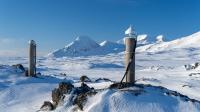HarSval – Polish-Norwegian research cooperation in Svalbard

GNSS reference stations operating at the Polish Polar Station Hornsund, managed by the WGiK WUT team, photo: Łukasz Kreft
The Polish-Norwegian project HarSval, carried out by the Faculty of Geodesy and Cartography at the Warsaw University of Technology (WGIK WUT), aims to strengthen bilateral relations between Norway and Poland, expand partner networks and the scope of current research activities, and ensure the transfer of knowledge, technology, and best practices. It is funded by the EEA grant and Norwegian Funds 2014-2021 under the Basic Research Program.
The work related to the HarSval project (Bilateral initiative aiming at Harmonisation of the Svalbard cooperation) has been ongoing since March 2024. The project was initiated by the Polish Polar Consortium, and involves 11 partners from Poland and 14 partners from Norway. The project leader is the Centre for Polar Studies at the University of Silesia.
Researchers from WUT in an international project
Tasks carried out within the HarSval initiative are divided into four main areas of activity:
- WP1: Activities aimed at modernizing and standardizing the Svalbard monitoring system in areas that are priorities for the Polish and Norwegian polar community.
- WP2: Activities aimed at developing competencies and skills, internationalization, and increasing the visibility of the Polish polar community, implemented in Polish-Norwegian cooperation.
- WP3: Activities in the area of FAIR data and open science.
- WP4: Activities in the field of popularization, communication, and management.
The activities of the Warsaw University of Technology team, consisting of Kinga Węzka (leader), Dariusz Gotlib, Marcin Rajner, Dominik Próchniewicz, Joanna Pluto-Kossakowska, Kamil Choromański, Miłosz Gnat, Paweł Kowalski, Andrzej Głażewski, and Hubert Świech, were defined in each of the areas.
As part of the WP3 work package, the team of WUT researchers, as its leader and main contractor, will design and implement the basic components of the Central Geospatial Services Server for the Polish Polar Data Base (PPDB). The developed database will consist of tools enabling integration with other polar research databases (e.g., SIOS Data Access Portal) – explains Kinga Węzka, MSc, the team leader from the Warsaw University of Technology.
PPDB will be built using a cloud-based platform for the Centre for Geospatial Analysis and Satellite Computing (CENAGIS). Additionally, PPDB will have implemented tools and applications for geovisualization and data analysis, taking into account the use of big data and artificial intelligence. As part of WP3, the WUT team will also support data sharing by qualified Data Stewards. Workshops and training will be conducted to increase scientists' skills in data sharing in accordance with the FAIR principles – the nearest workshops for project members and PKPol representatives will take place on June 20-21 at the Scientific and Educational Center in Józefosław. The workshops will be led by specialists from Norwegian partner institutions and representatives of the National Science Centre (NCN).
As part of activities related to WP1, the WUT team actively participates in the WetSnowEx action (Interdisciplinary study of snow ecosystems in Svalbard during the melting period). The planned research aims to determine the possibilities of using satellite images to analyze the variability of snow and ice cover, as well as their properties such as albedo or melting degree (phase). Within this task, field research was also conducted and data collected to develop a methodology for recognizing snow and ice cover and attempting to classify it using machine learning methods. As a result of experiments conducted in three research areas in Svalbard using multispectral Dove (Planet) data, the high usefulness of these images for determining the extent of snow cover was demonstrated. Significant fluctuations in snow cover during the melting season allow for detailed determination of snow ranges and uncovered areas (with vegetation and rocks).
Significant fluctuations in snow cover during the melting season allow for detailed determination of snow ranges and uncovered areas (with vegetation and rocks), as seen in the following sequence of images from the Hornsund region, partially showing the Hansa glacier. The presented images are shown in the form of color compositions using near-infrared (hence the vegetation is visible in red) from April to August 2022.
Additionally, as part of the WetSnowEx action, the WUT team will also measure the acceleration of gravity at the Polish Polar Station Hornsund this summer using a spring gravimeter. The measurements will constitute the initial epoch for future monitoring of changes in gravity acceleration within the Hornsund fjord in Svalbard. Determining the value of gravity acceleration provides indirect information about geodynamic processes occurring on a local scale, and their joint interpretation with GNSS data provides valuable information about the dynamics of environmental changes around measurement stations.
As part of activities in the WP2 area, representatives of the WUT team will complete internships at Norwegian research institutions.











